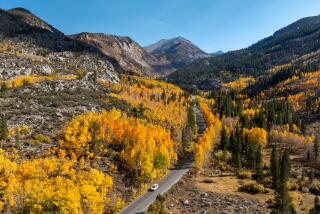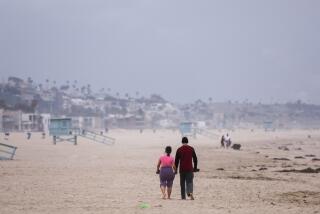Summertime fog preserves relic coastal pine forests
May gray. June gloom. Even fog in August, some wags call âFaugest.â
It turns out that the summertime bane of Southern California beachgoers provides a lifeline for the relic forest of bishop pines on two of the Channel Islands off Santa Barbara.
Itâs not just that the ground-hugging clouds shade these trees from soil-parching sun. The needles of these pine trees rake the fog, collecting droplets of water that fall to the forest floor. That moisture feeds to soil microbes that release nutrients and allow the trees to grow longer during the dry season, according to a study published in Global Change Biology.
Thousands of years ago, when the climate was cooler and wetter, the bishop pines proliferated throughout Southern California and even into Mexico, scientists believe. Today, their range is limited to places farther north in coastal California, with a few stands remaining on Santa Cruz and Santa Rosa islands off Santa Barbara and an island off Baja California.
These pines have persevered because they stand in the foggiest areas, said Mariah S. Carbone, the studyâs lead author and postdoctoral researcher at UC Santa Barbaraâs National Center for Ecological Analysis and Synthesis.
Fog often arrives in Southern California from May through August as the land warms and moist ocean air is pulled over cold, upwelling coastal waters. The moist air condenses, becomes trapped under an atmospheric inversion layer, and forms low clouds.
This fog often rides the marine layer ashore until the heat of the sun burns it off â at least inland.
It often persists over the ocean, which doesnât warm up like the land. For that reason, the islandâs bishop pines are far more likely to remain swaddled in a blanket of summertime fog.
Carbone studied the fog, the trees and soil microbes to look at changes in the carbon cycle that are likely to come with warming temperatures associated with climate change.
A warmer atmosphere can hold more water vapor, and scientists around the world have been measuring heavier downpours in flood-prone areas and more intense droughts in arid areas. Although the science is still emerging, shifting rainfall patterns are expected to amplify natural disasters and disrupt predictable weather needed to grow crops and provide steady, secure food supplies to poor nations in Asia and Africa.
When it comes to coastal fog in Southern California, the future is, well, far hazier.
âIt could be warmer and drier or warmer and wetter,â Carbone said. âWe really donât know.â
No pattern has yet emerged to support complaints by coastal residents that the summers seem to be getting foggier, she said. A. Park Williams, a climatologist and coauthor of the study, continues to look into the matter, scrutinizing decades of airport cloud records.
As for Carbone, she has adopted a different take on fog, after spending years measuring nourishing droplets that preserve the last stands of bishop pines.
âI used to not like fog,â she said. âBut now, I get excited when itâs foggy outside.â






